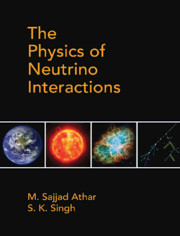Book contents
- Frontmatter
- Dedication
- Contents
- List of Figures
- List of Tables
- Preface
- Acknowledgments
- Chapter 1 Neutrino Properties and Its Interactions
- Chapter 2 Relativistic Particles and Neutrinos
- Chapter 3 Quantization of Free Particle Fields
- Chapter 4 Interacting Fields and Relativistic Perturbation Theory
- Chapter 5 Phenomenological Theory I: Nuclear β-decays and Weak Interaction of Leptons
- Chapter 6 Phenomenological Theory II: Weak Decays of Hadrons
- Chapter 7 Gauge Field Theories and Fundamental Interactions
- Chapter 8 Unified Theory of Electroweak Interactions
- Chapter 9 Neutrino and Electron Scattering from Point Particles
- Chapter 10 Neutrino scattering Cross Sections from Hadrons: Quasielastic Scattering
- Chapter 11 Neutrino Scattering from Hadrons: Inelastic Scattering (I)
- Chapter 12 Neutrino Scattering from Hadrons: Inelastic Scattering (II)
- Chapter 13 Neutrino Scattering from Hadrons: Deep Inelastic Scattering
- Chapter 14 Weak Quasielastic v(⊽)-nucleus Scattering
- Chapter 15 Inelastic Scattering of (Anti)neutrinos from Nuclei
- Chapter 16 Deep Inelastic Scattering of (Anti)neutrinos from Nuclei
- Chapter 17 Neutrino Sources and Detection of Neutrinos
- Chapter 18 Neutrino Mixing and Oscillations
- Chapter 19 Neutrino Astrophysics and the Synthesis of Elements
- Chapter 20 Neutrino Interactions Beyond the Standard Model
- Appendices
- Appendix A Lorentz Transformation and Covariance of the Dirac Equation
- Appendix B Cabibbo Theory
- Appendix C Some Properties of Pauli and Dirac Matrices and Spin Density Matrices
- Appendix D Leptonic and Hadronic Tensors
- Appendix E General Expression for the Total Scattering Cross Section and Decay Rates
- Appendix F Expressions of N(q2), the Coefficients of the Polarization Observables
- References
- Index
Appendix A - Lorentz Transformation and Covariance of the Dirac Equation
Published online by Cambridge University Press: 22 May 2020
- Frontmatter
- Dedication
- Contents
- List of Figures
- List of Tables
- Preface
- Acknowledgments
- Chapter 1 Neutrino Properties and Its Interactions
- Chapter 2 Relativistic Particles and Neutrinos
- Chapter 3 Quantization of Free Particle Fields
- Chapter 4 Interacting Fields and Relativistic Perturbation Theory
- Chapter 5 Phenomenological Theory I: Nuclear β-decays and Weak Interaction of Leptons
- Chapter 6 Phenomenological Theory II: Weak Decays of Hadrons
- Chapter 7 Gauge Field Theories and Fundamental Interactions
- Chapter 8 Unified Theory of Electroweak Interactions
- Chapter 9 Neutrino and Electron Scattering from Point Particles
- Chapter 10 Neutrino scattering Cross Sections from Hadrons: Quasielastic Scattering
- Chapter 11 Neutrino Scattering from Hadrons: Inelastic Scattering (I)
- Chapter 12 Neutrino Scattering from Hadrons: Inelastic Scattering (II)
- Chapter 13 Neutrino Scattering from Hadrons: Deep Inelastic Scattering
- Chapter 14 Weak Quasielastic v(⊽)-nucleus Scattering
- Chapter 15 Inelastic Scattering of (Anti)neutrinos from Nuclei
- Chapter 16 Deep Inelastic Scattering of (Anti)neutrinos from Nuclei
- Chapter 17 Neutrino Sources and Detection of Neutrinos
- Chapter 18 Neutrino Mixing and Oscillations
- Chapter 19 Neutrino Astrophysics and the Synthesis of Elements
- Chapter 20 Neutrino Interactions Beyond the Standard Model
- Appendices
- Appendix A Lorentz Transformation and Covariance of the Dirac Equation
- Appendix B Cabibbo Theory
- Appendix C Some Properties of Pauli and Dirac Matrices and Spin Density Matrices
- Appendix D Leptonic and Hadronic Tensors
- Appendix E General Expression for the Total Scattering Cross Section and Decay Rates
- Appendix F Expressions of N(q2), the Coefficients of the Polarization Observables
- References
- Index
Summary
Lorentz Transformations
Lorentz transformation (L.T.) is the rotation in Minkowski space. Minkowskispace is the mathematical representation of the space time inEinstein's theory of relativity. Unlike the Euclidean space,Minkowski space treats space and time on a different footing and the spacetime interval between the two events would be the same in all frames ofreference.
If an event is observed in an inertial frame S at thecoordinates (x, y, z,t) (Fig.A.1) and in another inertial frame at thecoordinates and the frame is moving with a constant velocityv with respect to S in the directionof x, then the measurements in S andS’ are related by
where
The L.H.S. of these equations describe the transformation of the coordinatesfrom S to S’ and theR.H.S. of the equations describe the transfer of coordinates fromS’ to S.Equation (A.1) may also be written as
The invariant length element squared ds2 is defined as
where is a contravariant vector and is a covariant vector. The metric tensoris defined as
One may rewrite Eq. (A.2) as
Where is the Lorentz transformation matrix. Any set of quantities which havefour components and transform like Eq. (A.5) under L.T. form a four vector,that is,
with the properties
For an infinitesimal may also be written as The tensor generates theinfinitesimal L.T. and it is considered to be a quantity that is smallerthan unity. The major contributor is (unit matrix) and generatesinfinitesimal boost or infinitesimal rotation or both. This can beunderstood as demonstrated in the next section.
Rotation of coordinates around the zaxis in 3D
If we consider the rotation around the z-axis by an angleθ, then
In the matrix form, Eq. (A.7) can be written as
For an infinitesimal rotation, that is,
where represents an infinitesimal rotation if. Equation (A.7) can berewritten as
The matrix representing the infinitesimal change is antisymmetric.Reconsidering Eq. (A.2),
When and Now and is given by
For an infinitesimal boost or rotation, that is,
Therefore, Eq. (A.11) implies that
Now,
The second term on the R.H.S. of Eq. (A.13) can be neglected as it is theproduct of two infinitesimal numbers, that is,
Since should be an invariant quantity,
that is, Eq. (A.14) shows antisymmetry. Therefore, the generator of an L.T.must be an antisymmetric matrix.
- Type
- Chapter
- Information
- The Physics of Neutrino Interactions , pp. 795 - 806Publisher: Cambridge University PressPrint publication year: 2020

